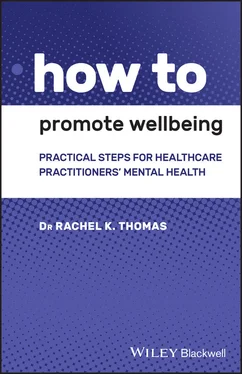1 Cover
2 Title Page
3 Copyright Page
4 About the author
5 Acknowledgements
6 Preface
7 Introduction Learning outcomes Why should we be concerned about our own wellbeing? Why should we consider both problem factors and protective factors?
8 Chapter 1: General problem factors affecting global mental health and wellbeing Problem factor: Global mental health burden Problem factor: Accessing resources Problem factor: Multiple potential impacts on individual mental health Problem factor: The acute and chronic stress responses Problem factor: The diathesis‐stress model Problem factor: Stigma
9 Chapter 2: Problem factors affecting healthcare practitioner mental health and wellbeing Problem factor: Perceptions of invulnerability Problem factor: Presenteeism Problem factor: Perceptions of hierarchy Problem factor: Burnout Problem factor: Compassion fatigue Problem factor: Perfectionistic personality traits Problem factor: Lack of recovery behaviours Problem factor: Sleep cycle derangement and sleep deprivation
10 Chapter 3: Problem and protective factors affecting patients’ mental health and wellbeing Factor to consider: The interlinkage of mental and physical health Factor to consider: Sleep Factor to consider: Diet Factor to consider: Cognitive aspects
11 Chapter 4: Protective factors for organisational implementation Protective factor: Organisational resilience Protective factor: Organisational approaches to addressing stigmatisation Protective factor: Creating a culture of support Protective factor: Facilitating access and awareness of support avenues Protective factor: Promoting communication Protective factor: Balancing the psychosocial safety climate Protective factor: Implementing a wellbeing strategy
12 Chapter 5: Protective factors for individual implementation Protective factor: Learning a new wellbeing skill Protective factor: Defining motivation to change Protective factor: Individual resilience Protecting factor: Compassion satisfaction and self‐care Protective factor: Promoting individual action Protective factor: Awareness and mitigation of risk factors for burnout Protective factor: Recognising and intervening approaching burnout and compassion fatigue Protective factor: Connection Protective factor: Access to support Protective factor: Judicious use of standardised processes and templates Protective factor: Practising self‐awareness and meditation/mindfulness Protective factor: Adequate sleep Protective factor: Balanced diet Protective factor: Adequate hydration Protective factor: Optimising thinking styles Protective factor: Appropriate delegation Protective factor: Reflection on personal accomplishment Protective factor: Physical activity Protective factor: Gratitude practices
13 Chapter 6: Protective factors for individual trainee/student implementation Protective factor: Medical school education styles Protective factor: Good habits around maintaining patient confidentiality Protective factor: Maintaining thorough record keeping Protective factor: Maintaining clear communication Protective factor: Planning training requirements
14 Chapter 7: Emergencies in mental health and wellbeing Professional emergency: Pandemics Professional emergency: Patient mental health Professional emergency: Whistleblowing Personal emergency: Personal crisis
15 Chapter 8: Mental health and wellbeing toolkit Reframing Weighing the evidence Softening black‐and‐white thinking Focusing on the benefits Journaling Reflecting Challenging thought processes Pausing Delegating Working as a team Noticing anticipatory stress Accepting ‘good enough’ Replacing ‘should’ and ‘must’ Playing out ‘what if…?’ Connecting Mentoring and buddying‐up Being thankful Feeling a sensation Progressively relaxing our muscles Progressively mentally scanning our body Deep breathing Focusing on a physical sensation Moving Drinking de‐caffeinated drinks after 3pm Removing blue light after 8pm Prioritising sleep Starting and keeping to a regular sleep schedule Drinking enough water Eating well Sitting less Going outside Talking
16 ReferencesIntroduction Preface Chapter 1 Chapter 2 Chapter 3 Chapter 4 Chapter 5 Chapter 6 Chapter 7
17 Index
18 End User License Agreement
1 Chapter 3Table 3.1 The Patient Health Questionnaire (PHQ‐2).
1 Introduction Figure 0.1 Duties of a doctor registered with the GMC. Figure 0.2 Balancing problem and protective factors.
2 Chapter 1 Figure 1.1 Around 7 in 10 of the general population across the globe with a ... Figure 1.2 The biopsychosocial model indicates the interconnectedness betwee... Figure 1.3 Stress response chemical cascade. Figure 1.4 The stress response can impact on many different body systems....
3 Chapter 2Figure 2.1 Around 8 in 10 respondents were at high or very high risk of burn...Figure 2.2 Possible links between stress and infection rates.Figure 2.3 High levels of burnout in clinicians has been supported by resear...Figure 2.4 Compassion fatigue as conceptually linked to stress, burnout, and...
4 Chapter 3Figure 3.1 A virtuous cycle indicating how improving mental health can impro...
5 Chapter 4Figure 4.1 A framework for considering key areas of organisation resilience.Figure 4.2 Almost 10% (9%) of the respondents stated that they had not been ...Figure 4.3 Almost 20% (19%) of respondents stated that they would not ask fo...Figure 4.4 Our stress at work can be linked to the balance between the resou...
6 Chapter 5Figure 5.1 The stages of competence when learning a new skill.Figure 5.2 The division of self‐care into groups to facilitate improvement....Figure 5.3 Key areas of life, and our satisfaction in them, can be represent...Figure 5.4 Reflecting on these key areas can indicate where we can make impr...Figure 5.5 Never events.Figure 5.6 According to CBT, our thoughts, feelings and behaviours are all i...Figure 5.7 Our feelings can be divided into physical and emotional feelings,...Figure 5.8 Becoming aware of our thoughts, feelings and behaviours can help ...Figure 5.9 Worry exists on a spectrum.Figure 5.10 Our worries can be divided into different groups, including real...Figure 5.11 A decision tree can help decide how to manage our worries.
1 Cover
2 Table of Contents
3 Begin Reading
1 iii
2 iv
3 ix
4 x
5 xi
6 xii
7 1
8 2
9 3
10 4
11 5
12 6
13 7
14 8
15 9
16 10
17 11
18 12
19 13
20 14
21 15
22 16
23 17
24 18
25 19
26 20
27 21
28 22
29 23
30 24
31 25
32 26
33 27
34 28
35 29
36 30
37 31
38 32
39 33
40 34
41 35
42 36
43 37
44 38
45 39
46 40
47 41
48 42
49 43
50 44
51 45
52 46
53 47
54 48
55 49
56 50
57 51
58 52
59 53
60 54
61 55
62 56
63 57
64 58
65 59
66 60
67 61
68 62
69 63
70 64
71 65
72 66
73 67
74 68
75 69
76 70
77 71
78 72
79 73
80 74
81 75
82 76
83 77
84 78
85 79
86 80
87 81
88 82
89 83
90 84
91 85
92 86
93 87
94 88
95 89
96 90
97 91
98 92
99 93
100 94
101 95
102 96
103 97
104 98
105 99
106 100
107 101
108 102
109 103
110 104
111 105
112 106
Читать дальше












